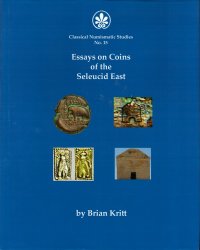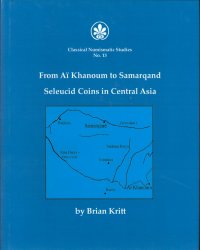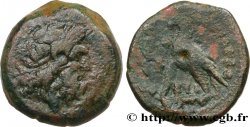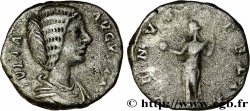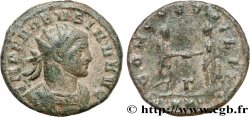la119 - Andragoras, Double Darics, and the coinage of Alexandria on the Oxus - Classical Numismatic Studies n°.14 KRITT Brian
65.00 €
Cantidad
Añadir a su cesta

Autore: KRITT Brian
Editor: CNG
Idioma: Anglais
Características: Lancaster 2022, relié sous jacquette (21 x 26 cm), 128 pages dont 8 planches, illustrations en couleur
Peso: 119 g.
Comentario
There is a series of Bactrian coins that have baffled numismatists since their discovery in the nineteenth century, the “Sophytes sequence” – a variety of coins, including imitations of Athenian coin types, and others, with groups of coins each bearing one of the names: Andragoras or Sophytes. There are ambiguous references to the first name in literary sources, as well as a name similar to the second. These sources however, are very misleading, and difficult to relate to the coins, which so far have resisted independent dating from their intrinsic numismatic identities.
In The Seleucid Mint of Aï Khanoum (2016), the present author happened upon two different coin types of the Sophytes sequence which were directly copied from datable Seleucid coins from the mint of Aï Khanoum, providing the first chronological fixed points for the Sophytes sequence. The more comprehensive study in this book has yielded a number of new connections of the Sophytes sequence coinagesto those of Aï Khanoum, and more generally, to the Seleucids. This has led to a complete and detailed new absolute chronology for the entire Sophytes sequence, and all of its component series.
A previously known coin type is now shown for the first time to be an unrecognized series of the Sophytes sequence: Bactrian versions of Persian style gold double darics, mostly from finds in the Oxus river valley, and India. These new coins have control links to various points in the Sophytes sequence. Some examples extend back in time to a point before the beginning of the previously known (silver) coins of the Sophytes sequence, and have numerous control connections to the Seleucid coinages of Babylon from the end of the fourth century.
This reveals a direct Seleucid intervention in the establishing of the coinages of the mint of the Sophytes sequence, including the transmission of the Babylon gold double daric type, originally created by Alexander the Great at Babylon, to this pre-existing city on the Oxus river. All evidence points to that city being the long sought Bactrian colony of Alexander, Alexandria on the Oxus river.
Many related historical details also follow from this analysis, including direct involvements of the Seleucids with this city for decades, until the outbreak of hostilities put an end to this relationship, and to the reign of the last known ruler of the colony, Sophytes.
There is a series of Bactrian coins that have baffled numismatists since their discovery in the nineteenth century, the “Sophytes sequence” – a variety of coins, including imitations of Athenian coin types, and others, with groups of coins each bearing one of the names: Andragoras or Sophytes. There are ambiguous references to the first name in literary sources, as well as a name similar to the second. These sources however, are very misleading, and difficult to relate to the coins, which so far have resisted independent dating from their intrinsic numismatic identities.
In The Seleucid Mint of Aï Khanoum (2016), the present author happened upon two different coin types of the Sophytes sequence which were directly copied from datable Seleucid coins from the mint of Aï Khanoum, providing the first chronological fixed points for the Sophytes sequence. The more comprehensive study in this book has yielded a number of new connections of the Sophytes sequence coinagesto those of Aï Khanoum, and more generally, to the Seleucids. This has led to a complete and detailed new absolute chronology for the entire Sophytes sequence, and all of its component series.
A previously known coin type is now shown for the first time to be an unrecognized series of the Sophytes sequence: Bactrian versions of Persian style gold double darics, mostly from finds in the Oxus river valley, and India. These new coins have control links to various points in the Sophytes sequence. Some examples extend back in time to a point before the beginning of the previously known (silver) coins of the Sophytes sequence, and have numerous control connections to the Seleucid coinages of Babylon from the end of the fourth century.
This reveals a direct Seleucid intervention in the establishment of the coinages of the mint of the Sophytes sequence, including the transmission of the Babylon gold double daric type, originally created by Alexander the Great at Babylon, to this pre-existing city on the Oxus river. All evidence points to that city being the long sought Bactrian colony of Alexander, Alexandria on the Oxus river.
Many related historical details also follow from this analysis, including direct involvements of the Seleucids with this city for decades, until the outbreak of hostilities put an end to this relationship, and to the reign of the last known ruler of the colony, Sophytes
In The Seleucid Mint of Aï Khanoum (2016), the present author happened upon two different coin types of the Sophytes sequence which were directly copied from datable Seleucid coins from the mint of Aï Khanoum, providing the first chronological fixed points for the Sophytes sequence. The more comprehensive study in this book has yielded a number of new connections of the Sophytes sequence coinagesto those of Aï Khanoum, and more generally, to the Seleucids. This has led to a complete and detailed new absolute chronology for the entire Sophytes sequence, and all of its component series.
A previously known coin type is now shown for the first time to be an unrecognized series of the Sophytes sequence: Bactrian versions of Persian style gold double darics, mostly from finds in the Oxus river valley, and India. These new coins have control links to various points in the Sophytes sequence. Some examples extend back in time to a point before the beginning of the previously known (silver) coins of the Sophytes sequence, and have numerous control connections to the Seleucid coinages of Babylon from the end of the fourth century.
This reveals a direct Seleucid intervention in the establishing of the coinages of the mint of the Sophytes sequence, including the transmission of the Babylon gold double daric type, originally created by Alexander the Great at Babylon, to this pre-existing city on the Oxus river. All evidence points to that city being the long sought Bactrian colony of Alexander, Alexandria on the Oxus river.
Many related historical details also follow from this analysis, including direct involvements of the Seleucids with this city for decades, until the outbreak of hostilities put an end to this relationship, and to the reign of the last known ruler of the colony, Sophytes.
There is a series of Bactrian coins that have baffled numismatists since their discovery in the nineteenth century, the “Sophytes sequence” – a variety of coins, including imitations of Athenian coin types, and others, with groups of coins each bearing one of the names: Andragoras or Sophytes. There are ambiguous references to the first name in literary sources, as well as a name similar to the second. These sources however, are very misleading, and difficult to relate to the coins, which so far have resisted independent dating from their intrinsic numismatic identities.
In The Seleucid Mint of Aï Khanoum (2016), the present author happened upon two different coin types of the Sophytes sequence which were directly copied from datable Seleucid coins from the mint of Aï Khanoum, providing the first chronological fixed points for the Sophytes sequence. The more comprehensive study in this book has yielded a number of new connections of the Sophytes sequence coinagesto those of Aï Khanoum, and more generally, to the Seleucids. This has led to a complete and detailed new absolute chronology for the entire Sophytes sequence, and all of its component series.
A previously known coin type is now shown for the first time to be an unrecognized series of the Sophytes sequence: Bactrian versions of Persian style gold double darics, mostly from finds in the Oxus river valley, and India. These new coins have control links to various points in the Sophytes sequence. Some examples extend back in time to a point before the beginning of the previously known (silver) coins of the Sophytes sequence, and have numerous control connections to the Seleucid coinages of Babylon from the end of the fourth century.
This reveals a direct Seleucid intervention in the establishment of the coinages of the mint of the Sophytes sequence, including the transmission of the Babylon gold double daric type, originally created by Alexander the Great at Babylon, to this pre-existing city on the Oxus river. All evidence points to that city being the long sought Bactrian colony of Alexander, Alexandria on the Oxus river.
Many related historical details also follow from this analysis, including direct involvements of the Seleucids with this city for decades, until the outbreak of hostilities put an end to this relationship, and to the reign of the last known ruler of the colony, Sophytes








 Informar de un error
Informar de un error Imprimir la página
Imprimir la página Comparte mi selección
Comparte mi selección Haz una pregunta
Haz una pregunta
 Descriptivo
Descriptivo